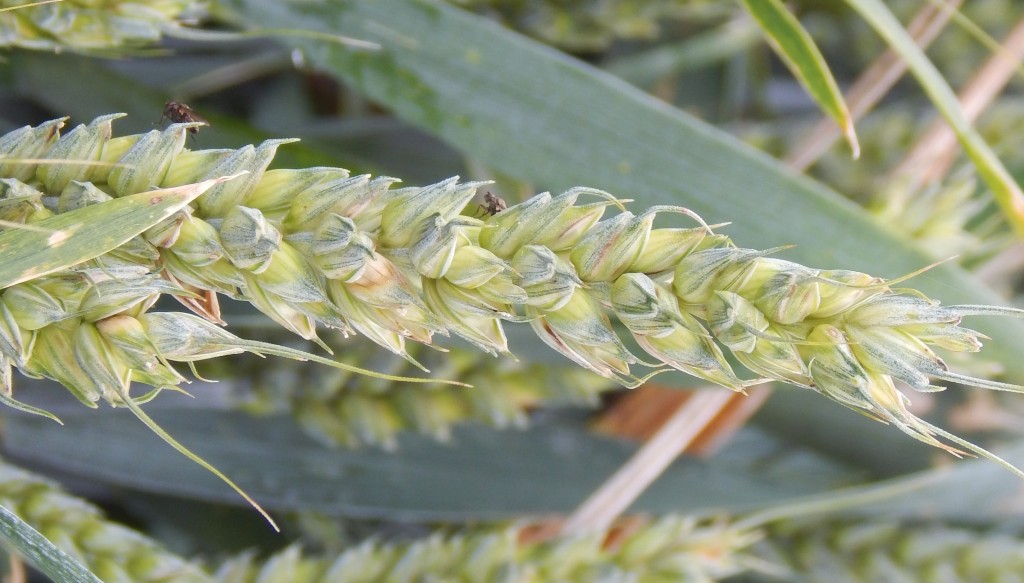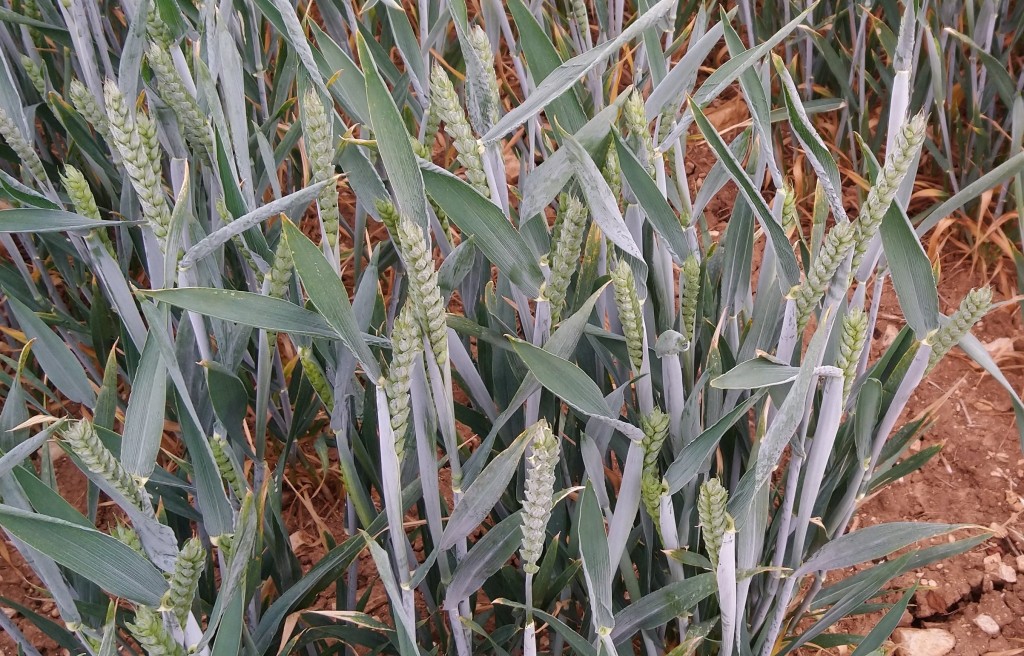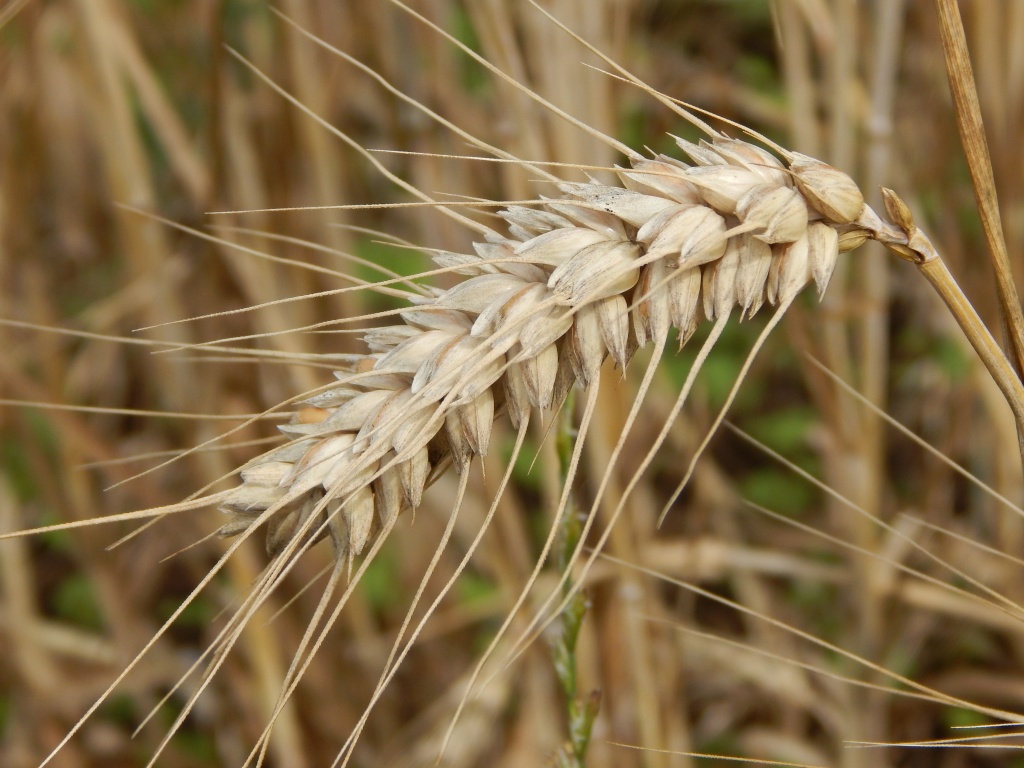
[345] Triticum aestivum, Wheat
Introduction
Triticum aestivum, Wheat, is the familiar, very widely cultivated crop species from which we get the flour for bread and other culinary uses. It is less common as a farmed species in Britain than fifty years ago but is still the most common arable crop.
There are many Triticum species, hybrids and varieties also called wheat so Triticum aestivum may be called Common Wheat or Bread Wheat.
In Britain (but not in the USA and Canada) the word corn can be used generically for grain crops such as wheat.
Taxonomy
Kingdom – Plants
Division – Vascular Plants
Class – Angiosperms (Flowering Plants)
Clade – Monocots
Clade – Commelinids
Order – Poales
Family – Poaceae
Clade – BOP Clade
Subfamily – Pooideae
Supertribe – Triticodae
Tribe – Triticeae
Genus – Triticum
Scientific Name – Triticum aestivum
It has the scientific synonyms Triticum sativum and Triticum vulgare and is sometimes mis-spelled as Triticum aestivatum.
Wheat has been cultivated for at least 10 000 years and it is a complex hybrid. See text for more details. Many varieties are cultivated.
Name
Wheat comes from old Germanic roots and is cognate with white.
The Latin word triticum for wheat comes from tritus the perfect passive of ‘to grind,’ (so it means ‘has been ground.’) Aestivum means Summer.
[The word ‘flour’ is generally pronounced the same as ‘flower’ and until the Nineteenth Century it was spelled the same with a similar meaning – the finest portion of ground grain. It gradually replaced the older word ‘meal,’ which remains in words like ‘wholemeal’ and ‘oatmeal.’]
History and Origins
Bread Wheat is a hexaploid species. It has six sets of chromosomes – three pairs of sets. These are presumed to have arisen naturally in the same way as the Triangle of U that we met in [057] Oilseed Rape.
Types of wheat have been domesticated since about 10 000 BC, towards the end of the Stone Age, in Western Asia. It spread to Europe, North Africa and East Asia in prehistoric times.
About 8 000 BC ago Triticum urartu, Einkorn Wheat, was hybridized with a close relative of Aegilops speltoides to produce the tetraploid species Triticum turgidum, Durum Wheat. Then about 6 500 BC, this species was hybridized with Aegilops tauschii, Wild Goat-grass, to produce the hexaploid Triticum aestivum.
[The two genera Triticum, wheat, and Aegilops, wild goat grasses, are very close and are sometimes treated as a single genus.]
It has gradually replaced other types of wheat, barley and rye as the source of flour for breadmaking.
Description
The sight of wheat field is very familiar but you may not see it in its early growing stages. It is like a type of grass, with long thin green leaves but the flowers and fruit soon develop and take over.



It is more familiar in late summer when the whole plant turns a light brown colour and all that is visible is the ears of corn.




It is now generally seen in very large fields, cultivated with such precision that the straight-line gaps left by the tractor wheels are clearly seen.



Modern varieties have been developed to grow to an even height and stalks are much shorter than they were fifty years ago.
Habitat and use
Wheat is of course a crop species and it is widely cultivated throughout the World. About 95% of the worldwide cultivated wheat production is Triticum Aestivum. Almost all of the rest is Triticum durum, Durum Wheat, Macaroni Wheat or Pasta Wheat.
There are some other species of Triticum and there are many hybrids, varieties and cultivars.
Wheat and Flour
I could probably write a book about wheat, flour and breadmaking but I don’t want to say much about what comes after the growing process. The wheat is harvested and threshed to remove the out layers of chaff. Then the seeds are normally ground into many different forms of flour.
Flour is not only used for bread. It goes into many other cooked products – especially pastry, pasta, cakes and biscuits, and is used as a thickening agent.
China, Europe, India and the USA are the main producers of wheat.
In the UK, wheat and cow’s milk are the two most valuable agricultural products, both significantly ahead of the next three products – sugar beet, potatoes and barley. We produce about 15 million tonnes of wheat per year, of which about a third goes to human consumption
Other Notes
In some other countries, flour can be produced from many other substances, for example soya and other beans, and chestnuts.

See also
Two other important arable crops come from the same Tribe, Triticeae.
- [177] Hordeum vulgare, Barley
- Secale cereale, Rye
Oats come from a more distant different supertribe, and [364] Maize is not even in the same subfamily.
